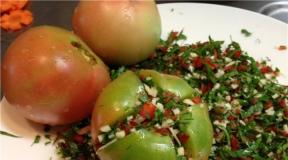Calories in grapes. Calories and nutritional value of grapes
Grapes are not as often used for diets as other fruits because of its supposedly high calorie content. However, in fact, calorie grapes are not as great as other sweet foods. 100 grams of grapes contain from 65 to 72 calories, depending on the grape variety. Sweeter grapes will have a higher caloric content than more acidic ones, but this difference is not so significant. The color of the grapes is also of little importance, since the dark and light grape varieties have approximately the same caloric content. However, dark varieties contain more nutrients, including antioxidants, than white ones. However, it is darker varieties that are more often allergic.
Grapes have long been famous for their health benefits. It contains a large amount of vitamin, trace elements, as well as flavonoids - substances that slow down aging and reduce the effects of harmful free radicals on human cells.
It is very useful to use grapes with bones and skin, which contain a large number of useful substances that contribute to the improvement of the body, its cleansing and weight loss.
It should be noted that it is most beneficial to eat fresh grapes. Therefore, in the season of ripening of this tasty berry it will be useful to spend several days on the grape diet. It is also recommended to add 200-300 grams of grapes per day to your daily diet. It is best to use it in a separate meal. This will help your body, strengthen the heart, blood vessels, improve the work of the kidneys and gallbladder. However, it should be remembered that grapes raisins for many calories other varieties - 95 calories per 100 grams
Below is a table of calories and nutritional value of grapes .
| The product's name | Grams of product | Contains |
| grapes | 100g | 72 kcal |
| grapes sour varieties | 100g | 65 kcal |
| white grapes | 100g | 43 kcal |
| red grapes | 100g | 64 kcal |
| grape raisin | 100g | 95 kcal |
| dried grapes raisins | 100g | 270 kcal |
| proteins | 100g | 0.6 grams |
| fat | 100g | 0.6 grams |
| carbohydrate | 100g | 15.4 grams |
| dietary fiber | 100g | 1.6 grams |
| water | 100g | 80.5 grams |
100 grams contain the following trace elements: Iron 0.6 mg, Zinc 0.91 mg, Iodine 8 µg, Copper 80 µg, Manganese 0.09 mg, Chromium 3 µg, Fluorine 12 µg, Molybdenum 3 µg, Bor 365 µg, Vanadium 10 µg, Silicon 12 mg, Cobalt 2 mcg, Aluminum 380 mcg, Nickel 16 mcg, Rubidium 100 mcg
100 grams of grapes contain the following vitamins: Vitamin PP, Beta-carotene, Vitamin A, Vitamin B1, B2, B5, B6, B9, Vitamin C, Vitamin E, Vitamin H, Vitamin PP.
Nika Sestrinskaya - specifically for the site site
Grapes are very tasty berries. Who among us does not love these fragrant sunny berries? Probably, such people are very few in the world. About their benefits and nutritional value known since ancient times.
Due to the fact that in recent years the number of people who are calculating the energy value of their diet has been growing, we will examine in more detail the question of the calorific value of grapes of various varieties.
Energy value of the product
How many calories are contained in berries of different types can be found in the table:
Favorite raisin varieties are very sweet, contain up to 23% sugar. Examples of the energy value of some seedless varieties:
- Calorie grapes "Kishmish", the berries of which are white or amber-yellow and do not contain seeds, is 95 Kcal.
- Calorie grapes of black early varieties "Glenora" is 90 Kcal.
- "Raisin" - pink, with a calorie grape per 100 grams of product 85 Kcal.
About how many calories in grape berries with stones will be discussed further. But it can be said that on average the energy value of the grapes is 43-75 kcal per 100 grams of product. For example, the old oriental pink "Tayfi" contains 75 Kcal.
Nutritional value of the product
The nutritional value of the clusters of the vine has some features depending on the type and variety. The ratio of proteins, fats and carbohydrates in fruits of different types is reflected in the table:
| Kinds | Squirrels | Fat | Carbohydrates |
|---|---|---|---|
| Green | 0.60 grams | 0.20 grams | 16.30 grams |
| The black | 0.70 grams | 0.20 grams | 16.80 grams |
| Red (pink) | 0.60 grams | 0.20 grams | 15.20 grams |
| White | 0.60 grams | 0.10 grams | 15.20 grams |
Interesting Facts:
- The main part of the proteins is contained in the peel of the fruit, and its pulp is only 20%, so it needs to be chewed thoroughly in order to digest more protein.
- Fresh grapes 10 times less carbohydrates than raisins.
- Fats are found only in the seeds of the vine. They have strong anti-aging properties, so the bones should not be spat out, but should be chewed and swallowed with the pulp.
Calorie wine

Wine is an excellent drink that preserves the benefits of the fresh fruits of the vine. It is made from white, red and black wine varieties. Technologies for making wines can be different, but the principle is one: the fermentation of juice under the influence of bacteria.
Calorie content homemade wine of grapes with sugar depends on the type of vine, but an average of 120 kilocalories.
Black color fruit indicates that the clusters are very sweet and healthy, and dry homemade wine of them has about 65-70 calories.
Beautiful color wine gives red grapes. Semi-sweet wine from it contains 120-150 kilocalories per 100 grams.
Calorie content grape green the lowest, it is 50 kilocalories. But only green berries do not make wine, they are most often used for making alcohol or are part of dessert wines.
The most popular wine from white varieties these berries. The energy value of such drinks varies from 65 kilocalories in dry white wine to 100 kilocalories in semisweet champagne and 120 Kcal in sweet white.
Today it is unlikely that you will surprise anyone with grapes on the table, it is not perceived as exquisite food. But the berries are able to satisfy every whim. Sour, sweet, sour-sweet, white, green, red, black grapes ...
In short, a select bunch of grapes will become a real decoration of a dinner party for the whole family or a romantic dinner for two lovers.
Grapes - the most ancient plant, which occupies an important place in the cultures of a number of civilizations and religious movements.
- The myths of ancient Greece and Rome - the youngest son of the great Zeus, the god of winemaking and unbridled merriment Dionysus appeared on all images with a bunch of berries in his hands;
- Ancient Egypt - the god Osiris taught the Egyptian people to break vineyards;
- The biblical writings - after the Flood, the only saved representative of humanity, Noah, bailiff on his ark to the land, or rather, Mount Ararat, immediately planted grapes;
- Christianity - the blood of Jesus Christ is symbolized with wine, and these berries are also associated with wealth and fertility.

The canvases of great artists depict still lifes with a vine and clusters of fruits, scenes from the life of collectors on plantations. “The war can wait, the vintage is not,” is the old French proverb.
Recently, a lot of heated debate has flared up on the topic of the benefits and harm to the body of grapes. A criterion that plays against this product is a large amount of sugar. His presence automatically taboos the appearance of ripe grapes on our table. Excess sugar - extra calories. This axiom becomes the main stumbling block. Useful properties of grapes inevitably fade into the background.
But let's still not forget the three pillars of harmonious power. Success is achieved through a rational approach, maintaining a balance in the ratio of proteins, fats and carbohydrates, as well as avoiding any extremes.
To buy grapes, we will clearly move towards the sign "Fruit-vegetables".
If we follow the botanical definition, a fruit is a juicy and edible fruit, a part of a plant that develops from a flower and has seeds inside it. In the people, berries are often called the same and fruits.
But from the point of view of science, a berry is a fruit with pulp, thin skin and seeds. If we open the Ozhegov dictionary, there we will find a description of the berry as a fruit that grows on shrubs, herbaceous plants and shrubs.
Botany says that a berry is a fruit with many seeds, but the concept of “fruit” as such is not used in this science. And in our language, as a rule, the words “fruit” and “fruit” often replace each other. Just the word "fruit" is more domestic, but we love to call fruits fruit.
And so biologists have definitely determined that the grapes are a berry, a fruit with juicy pulp and small bones covered with a thin peel.
The composition and beneficial properties of grapes
If we say that a plant pampered by the sun is a storehouse of substances useful to the human body, this will not be an exaggeration. The presence in the berries of a relatively high rate of glucose, fructose and sucrose add grape energy value.
However, the large amounts of vitamins in grapes clearly hint that its fruits must be more or less necessarily present in the diet.
Scientists looked deep inside and found that grapes contain the following valuable components:
- Fiber has a laxative effect of a mild nature. Grapes are definitely very useful for people suffering from chronic constipation. The berries gently envelop the intestines and contribute to the natural cleansing of the body from toxins;
- Fructose, sucrose and glucose of berries of natural origin, when absorbed into the blood, charge the body with force and are a source of additional energy. True, with this trinity you have to be very careful. Psychologically, it is hard to stop the absorption of berries, the tone is increased, and the feeling of satiety is almost absent;
- Essential trace elements and minerals. Potassium is indicated for diseases of the heart and blood vessels, which is why cardiologists are unanimously advising the cores to regularly eat a small portion of raisins. Calcium, sodium, phosphorus, magnesium, silicon, sulfur and this is not a complete list, among which iodine, fluorine, copper, etc .;
- Vitamins - the lion's share of vitamin C, ascorbic acid is a reliable defender of immunity and increase the protective properties. Vitamins of group B have a positive effect on the nervous system. Vitamin A is the first aid for eye diseases. Nicotinic acid (vitamin PP) lowers the risk of cardiovascular disease, lowers cholesterol and is involved in the vital process of transforming fat into energy;
- The essential antioxidants present in the berries protect our skin's youthfulness, making it supple and radiant. But it is outwardly. With arrhythmias and often accompanying hypertension, grape consumption normalizes heart rate and normalizes blood pressure.

As an example, consider green grapes from the side of BJU (formula of proteins, fats and carbohydrates in the product). It is believed that light colored berries are more neutral and easier to assimilate. The moment is more explained by personal preferences than by scientific facts. Although winemakers agree.
In grapes, the ratio of bju is calculated as follows: in 100 grams, proteins are equal to 60%, 25% are fats and close the chain of the remaining 15% of carbohydrates.
The rich chemical composition of the berries justifies the love of mankind for grapes cultivated since time immemorial, counted in years BC.
Calorie grapes
Grapes in the conventional sense is not a diet berry. But even in this situation, resourceful experts, to the infinite delight of sweet teeth, offer treatment with grapes. Berries have an independent term - ampelotherapy. It consists in observance of mono-diets for several days and will give a noticeable effect in the form of a reduction of a couple of kilograms.
The logic in this therapy is. Studying the properties of grapes, scientists have proved that a handful of fruits weighing 0.1 kg account for 43 to 95 kilocalories. The exact figure depends on the type of berries, although it is clear that there are very few calories.
As for the grapes calories in another popular modification - raisins, there is no dispute, it is high and a little less than 300 kilocalories. So maybe he should give up on this nutritional product? No need to hurry.
The use of grapes in a dried form is that it is not thermally processed, therefore, almost fully retains all the beneficial properties of its fellow fresh.
During exhausting catarrhal diseases, fruit drink from raisins will help restore strength and restore water balance.
In white
The calorie content of white grapes is one of the lowest, a little over 40 kilocalories. These include nutmeg varieties of berries, known for their delicate taste. The fruits of white grapes to match their exquisite bouquet have a tender flesh, covered with a thin peel of a light golden color. This variety of berries has one serious drawback, whimsicalness to weather conditions creates certain problems in its cultivation.
In green
Chardonnay, ladies' fingers, aligote with french roots, quiche mischa berries refer to the so-called green grapes. Clusters with this color are widely used in the production of wine. The calorie content of green grapes with stones varies between 40 and 75 kilocalories. But 100 grams of berries of the sweetest kish-misha contains the most - 95 kilocalories.
In red
Nutritiologi and nutritionists when choosing grapes prefer red varieties of berries, for a more pronounced antibacterial and antiviral effect. They are familiar to us by the names of Sauvignon, Pinot noir, Merlot. Calorie pink grapes are not higher than other sweets.
Contrary to the prevailing opinion, how many calories in red grapes, so much about and other varieties of berries, for example, green, and ranges from 60 to 75 kilocalories.
In black
Black grape is not difficult to grow in your backyard. Isabella's winding vine will be a wonderful decorative element and will add a special charm and comfort, for example, to your gazebo.
Calorie content of 100 grams of black grapes reaches 75 kilocalories, it is a lot. But you can close your eyes to this, since the flavors of the Isabella variety are unique and stand out among other types of grapes. Experienced sommeliers feel the richest bouquet of various shades from berry to fruit.
Despite the caloric content of dark grapes, people with cardiovascular diseases should pay attention to it in the first place.
What is useful blue grapes have long been known. Against the background of taking special drugs aimed at increasing iron in the blood, black fruits will become its effective additional source.
Glycemic index
We found out that the energy value of the grapes is not a weak point of the berry. What really should be alerted is its high glycemic index. This indicator indicates the rate of splitting of carbohydrates in food during consumption. The faster the breakdown of carbohydrates, the less the product brings feelings of saturation.
That is why it is so difficult to stop and limit to a few berries tricks, the volume of fructose and glucose comes in large quantities, but hunger does not leave.
The glycemic index of grapes of light varieties ranges between 45 and 60 units, while black is slightly less - from 43 to 54.
For example, spinach has a glycemic index of 15 units. Therefore, spinach eat more quickly than ripe berries.
What is useful for the human body?
A separate big topic is the healing properties of grapes, confirming a positive effect on the human body. Including berries in the diet, do not neglect the skin and bones.
Regular consumption of sweet fruits regulates the system of blood-forming organs, which will protect from external adverse effects. The production of red blood cells ensures a normal supply of oxygen and tissues.
When treating diseases of the heart and blood vessels, the fruits of the grapes will prevent the formation of blood clots and help to expand the blood vessels.
The use of these berries due to the presence in the composition of nicotinic acid reduces the level of cholesterol in the blood and helps to strengthen the walls of blood vessels.
How do grapes affect the human body, leading an average lifestyle? A glass of fresh juice of berries will provide vigor and energy. A natural anti-depressant will help overcome an unpleasant feeling of fatigue. It will also provide essential nitrogenous and tannins that are important for maintaining general immunity.
During intense mental stress, the solar fruits help improve memory and stimulate brain activity.

The benefits of grapes for the female body
What is useful grapes for the body of a woman? First of all, cosmetics based on its fruits have valuable cleansing and moisturizing properties. Masks, on the basis of berries, peels and scrubs delicately peel off the dead skin cells of the epidermis and accelerate the production of much-needed collagen and elastin.
Grape seed oil is used in cosmetology for all skin types. It is the only oil that is suitable even for the fat type.
Low calorie fruits allow you to include grapes in the diet menu. Juicy berries saturate the body with sufficient water, will remove slags and toxins. If this is not a three-day mono-diet, then the daily rate is 5 berries. Due to the high calorie content, raisins should be excluded from the diet.
Grape berries have long been used as a female aphrodisiac. This natural product arouses sexual attraction to its partner and helps to increase libido.

During critical days, fragile women often feel unwell and dizzy. Possible anemia will only exacerbate the problem, knocking out a rut for several days. Berries of red varieties will not allow hemoglobin in the blood to fall to a critical point.
Unfortunately, cancer is increasingly threatening the lives of people. Experts advise to include several berries in the daily diet for the prevention of malignant tumors in the mammary glands. The healing properties of grapes can be a good prevention of cancer.
Harm grapes
The best is the enemy of the good, the old saying applies to this product. Too many grapes can harm even a completely healthy person. A small bunch of berries weighing 100 grams is the limit that will benefit and will not cause damage to the body.
For whom there are contraindications:
- Diabetics due to high blood sugar levels;
- Allergy sufferers;
- People suffering from gastrointestinal diseases, especially during exacerbations;
- With obesity, despite the low calorie content;
- With caries and other problems with tooth enamel.
Fiber berries gently cleanses the intestines, but with diarrhea and other disorders, the laxative effect will do more harm than good. The presence of alcohol in the composition of the berries can adversely affect the mucous membranes of the gastrointestinal tract.
Fermentation properties of the berries will bring additional inconvenience during flatulence and increased gas formation, especially in combination with fatty foods. In this case, with the berries it is better not to be zealous and, in general, to use separately.
Who does not like to eat sweet and sour grapes? They perfectly satisfy hunger and thirst.
People from ancient times cultivate this plant, eat it and make excellent drinks based on it.
And yet - they are treated with various diseases, make oil, and elevate mood during depression.
Useful properties of grapes
The fruits of grapes contain trace elements necessary for the human body and mineral salts. These include potassium, magnesium, manganese, nickel, aluminum.
In addition, grapes are rich in plenty of vitamins (A, B1, B2, B3, B5, B6, B9, C, H, K, P) and amino acids (leucine, cystine, methionine, glycine, lysine, histidine). They are necessary to normalize the process of metabolism.
The skin of grapes contains essential oil, wax, coloring and tannins. The skin of red grapes also contains resveratrol. Scientists say that this natural phytoalexin can help in the fight against cancer.
Separately, it should be said about grape oil, which is contained in the seeds. Another name is grape seed oil. It is often used in cooking, cosmetology (mainly for softening and nourishing facial skin, hair care) and aromatherapy.
Benefit and harm
The grape has been used by man since ancient times not only as food or raw material for beverages, but also as a natural remedy and cleansing agent. However, in some cases, excessive or uncontrolled consumption of berries can harm the body. Therefore, you need to eat grapes wisely!
- Benefit
Grapes are useful to eat with diseases of the lungs, kidneys, digestive and cardiovascular systems, anemia. The nutrients contained in it normalize blood pressure and blood formation, improve metabolism and respiratory condition, alleviate joint pain, purify blood and excrete uric acid from the body.
If you have problems with the nervous system, depression and chronic fatigue, it is recommended to use natural grape juice. It tones the body as a whole, has diuretic and diaphoretic properties.
For prevention and just for your pleasure, eat grapes a couple of hours after eating.
- Harm
The skin of grapes promotes the formation of gases in the intestines, causing flatulence. If you have caries, eating grapes in large quantities is very harmful - it can accelerate the destruction of tooth enamel.
It is also undesirable to be treated with grapes or use it in large quantities without a doctor’s supervision in case of diabetes mellitus and obesity, during the exacerbation of gastric and intestinal diseases, in acute heart and kidney failure.
Calorie grapes
Grapes are considered one of the most high-calorie berries - it contains a lot of sugars. Depending on the variety, 100 grams of grapes can contain from 65 to 90 calories.
However, despite the high caloric content, with the help of grapes you can get rid of extra pounds and cleanse your body. If you do not have the contraindications indicated in the previous part of the article, in the summer you can spend a few days on the grape diet. You can also add it to your daily diet instead of a single meal.
In order to truly balanced diet, you should eat berries and fruits. Some of them can be eaten without limiting yourself, others - with great care. Most people rarely eat grapes, considering it to be high-calorie. But is this true?
This plant belongs to the oldest plants on Earth. He began to reclaim before our era. Mention of this berry is found in Egyptian letters. Now there are more than 3 thousand varieties, each of which has its own special color, taste and size.
Each of the varieties has its own different calorie content. The more sugars in the berries, the greater the number of calories, and accordingly, the more acidic the berry, the less calorie it is. Color, size and taste do not affect caloric content.
After drying, raisins retain around 80% of their vitamins and trace elements. At the same time it has a high caloric content - 264 kcal per 100 grams of product.
The table below shows the caloric content of different varieties of this berry.
These berries have the following chemical composition:

100 gr. fruits of this berry contains the following trace elements:
- Iron - 0.6 mg;
- Iodine - 8 mcg;
- Rubidium - 100 mcg.
- Fluorine - 12 mcg;
- Aluminum - 380 mcg;
- Cobalt - 2 mcg;
- Boron - 365 mcg;
- Chrome - 3 mcg;
- Zinc - 0.091 mg;
- Molybdenum - 3 mcg;
- Silicon - 12 mg;
- Copper - 80 mcg;
- Manganese - 0.09 mg;
- Vanadium - 10 mcg;
- Nickel - 16 µg;
100 grams of fruit has the following vitamins: Vitamin B1, B2, Beta-carotene, Vitamin PP, Vitamin A, B5, B6, B9, Vitamin C, Vitamin E, Vitamin H.
Grape varieties
It is necessary to elaborate on the varieties discussed in the table..
 Green - varieties of this color are sour, thanks to this they have a low calorie content. It has a useful ability to thin the blood. A person who wants to go on a diet may be wondering how many calories are in green grapes? Only 69 kcal, so it can be considered a low-calorie product.
Green - varieties of this color are sour, thanks to this they have a low calorie content. It has a useful ability to thin the blood. A person who wants to go on a diet may be wondering how many calories are in green grapes? Only 69 kcal, so it can be considered a low-calorie product.
White - varieties, distinguished by excellent taste and noble color. The berries of these varieties have large fruits, they are used in winemaking and consumed fresh. The berries of these varieties have the lowest calorie content among all grape varieties. Substances in its composition contribute to the strengthening of immunity.
Red - tasty and healthy varieties, which are famous for large and sweet berries. Although they are not as well known as white and black. Its fruits have an antibacterial effect..
Black - mostly berries of these varieties have medium size and a slight wax shine on the skin. Black grapes make wine. In its composition are resveratrol - a substance that contributes to the growth of duration and life.
Kishmish - has large clustersconsisting of small berries. He comes from Central Asia and the East. The berries are seedless, have a sweet taste, are well stored. They make wine from raisins, dry it. Nutrients contained in the raisins, help maintain the health of the nervous system. Calorie grape raisin is the largest of all varieties - 95 kcal per 100 grams.
There are much more varieties of this berry than in the presented description. Here are collected the largest subspecies, each of which consists of different varieties.
Beneficial features
 Due to its rich composition, grape fruits help normalize the work of the heart and vascular system, regulate pressure, and help cleanse the kidneys and liver of accumulated toxins. Grapes raise hemoglobin in the blood and helps to maintain immunity.
Due to its rich composition, grape fruits help normalize the work of the heart and vascular system, regulate pressure, and help cleanse the kidneys and liver of accumulated toxins. Grapes raise hemoglobin in the blood and helps to maintain immunity.
It is useful to eat with bone and skinIt is in it that there are many useful substances.
Regular consumption of grapes helps to reduce the risk of oncology, this happens because the berries of this plant contain many phytosterols, which have anti-cancer and immunostimulating effects.
The leaves and roots of this plant also have substances that are valuable to human health.
note, eating berries in fresh form brings more benefits. It is recommended to eat about 300 grams of these berries daily.
Use in diets
For supporters of proper nutrition is very important to know how many calories in grapes. The smallest number of calories have white varieties - 43 kcal. That they are advised to use during the diet. The greatest caloric content has a raisin - 95 kcal per 100 grams. berries and raisins - 264 calories.
But, if we compare this berry with other sweets, the caloric content of the grapes can be considered small.
Grapes are not so often used for diets, like other vegetables and fruits, considering it to be too high in calories. In fact, its caloric content is much lower than other sweetsFor example, the calorie content of green grapes is only 69 calories.
Many nutritionists advise replacing the berries with fresh juice, but you need to remember that the juice easily leads to irritation of the gastric mucosa, as well as a small amount of alcohol in the juice.
Contraindications
Mono-diet on grapes can lead to stomach ulcers and colitis. It is completely contraindicated for people with diabetes, obesity, an ulcer and heart failure.
Grape juice is very harmful to tooth enamel. and contributes to the formation of caries. In addition, grapes are a strong allergen.





















